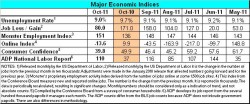 The unemployment rate nudged down, but new jobs in October fell short of what economists expected, according to numbers released this morning by the U.S. Department of Labor.
The unemployment rate nudged down, but new jobs in October fell short of what economists expected, according to numbers released this morning by the U.S. Department of Labor.
Economists were expecting at least 100,000 new jobs to have been created last month. Instead, the numbers show only 80,000 new non-farm jobs, all of them coming from the private sector. Government at every level cut a total of 24,000 positions, continuing a trend that began mid-2008 at the state and local levels.
The New York Times described the increase as “mediocre,” and said the report offers little guidance about the direction of the U.S. employment outlook.
Despite the minor drop in the unemployment rate — from the 9.1 percent where it’s been since July, to 9.0 percent — the Labor Department’s Bureau of Labor Statistics said the total number of unemployed barely changed. In October, there were 13.9 million Americans out of work. In October, the number was almost 14 million.
Although the change was slight, the ranks of the unemployed, especially those out of work for more than six months and those working part time because they can’t find full time positions, all showed declines from September. The BLS said the so-called involuntary part-timers declined 374,000 to 8.9 million. The long-term unemployed also declined 366,000 to 5.9 million.
One statistic that didn’t change is the number of the so-called marginally attached. These are people who didn’t search for work during the government’s survey period, but wanted a job. The BLS put that number at 2.6 million, almost the same as a year ago.
The government report doesn’t attempt to explain the decrease in the counts. However, it’s not because workers are dropping out of the labor force. The numbers in today’s report say labor force participation rate remained at 64.2 percent in October, and the employment-population ratio was little changed at 58.4 percent.
Workers with the least education are most affected by the economy. Among those without a high school degree the unemployment rate is 13.8 percent. High school grads have a 9.6 percent rate, and those with a college degree have only a 4.4 percent rate.
Rates also vary widely by the type of occupation.
“Although we are experiencing job growth, it’s still not the type of growth to push unemployment down. With that in mind, many individuals do not realize that when you breakdown the 9.0% unemployment rate, the percentage differs greatly based on education, skill and also geography,” observes Joanie Ruge, SVP & Chief Employment Analyst for Randstad Holding US.
“We continue to see a high demand for individuals who possess education and training in engineering, administrative and clerical, IT, and the healthcare field, as well as in the accounting and financial industry. And, finding the right match skill-set wise is still proving difficult for recruiters despite the type of job market we are in.”
Today’s report says most of the jobs in October came from professional and businesses services, leisure and hospitality, health care, and mining. The professional and business services sector, which is largely, but not entirely staffing and temp help, was up 32,000 jobs during the month. The sector has grown by 562,000 jobs in the last year.
Health care added 12,000 jobs and hospitality and leisure employers added 22,000 positions. Mining jobs, principally in the petroleum industry, grew by 6,000 positions.
The workweek didn’t change during the month remaining at 34.3 hours. Manufacturing hours increased by 0.2 hour to 40.5 hours, and factory overtime remained at 3.2 hours.
Average hourly earnings for all employees on private nonfarm payrolls increased by 5 cents, or 0.2 percent, to $23.19. This increase followed a gain of 6 cents in September. Over the past 12 months, average hourly earnings have increased by 1.8 percent.